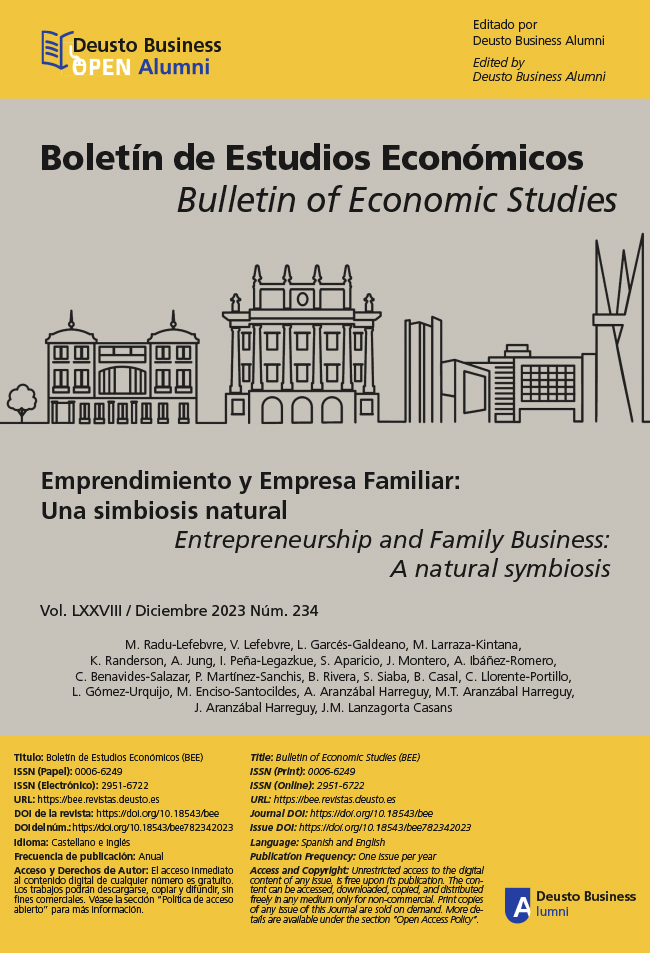Selection of partners and outcome of entrepreneurial teams: Should everything stay within the family?
Abstract
The view of the entrepreneur as a lone hero is very common in society. However, many new businesses are created by teams. Indeed, team ventures are more likely to make a profit, survive in the marketplace and grow rapidly than solo ventures. But to achieve a better outcome from the entrepreneurship process, it is not enough to form a team since it is also necessary to choose the right partners. In addition, being the family a context in which to look for potential partners to form entrepreneurial teams, it is key to consider how the composition of the entrepreneurial team influences the outcome of new family businesses. This article aims to answer these questions based on theory and data in order to provide practical guidance for those who are starting new businesses. In this regard, careful team members selection is fundamental, along with consideration of the limitations that family business teams may have.
Recibido: 14 June 2023
Aceptado: 28 August 2023
References
Aparicio. S., Audretsch, D., Noguera, M., & Urbano, D. (2022). Can female entrepreneurs boost social mobility in developing countries? An institutional analysis. Technological Forecasting and Social Change, 175, 121401. https://doi.org/10.1016/j.techfore.2021.121401
Audretsch, D. B. (2021). Have we oversold the Silicon Valley model of entrepreneurship? Small Business Economics, 56(2), 849-856. https://doi.org/10.1007/s11187-019-00272-4
Alvarez, S. A., & Busenitz, L. W. (2001). The entrepreneurship of resource-based theory. Journal of Management, 27(6), 755–775. https://doi.org/10.1016/S0149-2063(01)00122-2
Ben-Hafaïedh, C., & Cooney, T. M. (2017). Introduction. In C. Ben-Hafaïedh & T. M. Cooney (Eds.), Research Handbook on Entrepreneurial Teams (pp. 1–7). Edward Elgar Publishing. https://www.elgaronline.com/view/edcoll/9781784713195/9781784713195.00021.xml
Brannon, D. L., Wiklund, J., & Haynie, J. M. (2013). The Varying Effects of Family Relationships in Entrepreneurial Teams. Entrepreneurship Theory and Practice, 37(1), 107–132. https://doi.org/10.1111/j.1540-6520.2012.00533.x
Cooney, T. M. (2005). Editorial: What is an Entrepreneurial Team? International Small Business Journal, 23(3), 226–235. https://doi.org/10.1177/0266242605052131
Curtin, R. T., & Reynolds, P. D. (2018a). Panel Study of Entrepreneurial Dynamics, PSED I, United States, 1998-2004: Version 1 [Data set]. Inter-University Consortium for Political and Social Research. https://doi.org/10.3886/ICPSR37203.V1
Curtin, R. T., & Reynolds, P. D. (2018b). Panel Study of Entrepreneurial Dynamics, PSED II, United States, 2005-2011: Version 1 (Version v1) [Data set]. ICPSR - Interuniversity Consortium for Political and Social Research. https://doi.org/10.3886/ICPSR37202.V1
Dimov, D. (2010). Nascent Entrepreneurs and Venture Emergence: Opportunity Confidence, Human Capital, and Early Planning. Journal of Management Studies, 47(6), 1123–1153. https://doi.org/10.1111/j.1467-6486.2009.00874.x
Discua Cruz, A., Hadjielias, E., & Howorth, C. (2017). Family entrepreneurial teams. In Research Handbook on Entrepreneurial Teams (pp. 187–207). Edward Elgar Publishing.
Discua Cruz, A., Howorth, C., & Hamilton, E. (2013). Intrafamily Entrepreneurship: The Formation and Membership of Family Entrepreneurial Teams. Entrepreneurship Theory and Practice, 37(1), 17–46. https://doi.org/10.1111/j.1540-6520.2012.00534.x
González-Pernía, J. L., Guerrero, M., Montero, J., & Peña-Legazkue, I. (2019). La travesía desde la concepción de la idea de negocio a la realidad empresarial. In I. Peña-Legazkue, M. Guerrero, J. L. González-Pernía, & J. Montero, Global Entrepreneurship Monitor: Informe GEM España 2018-2019. Editorial de la Universidad de Cantabria. https://doi.org/10.22429/euc2020.024
Grossman, E. B., Yli-Renko, H., & Janakiraman, R. (2012). Resource Search, Interpersonal Similarity, and Network Tie Valuation in Nascent Entrepreneurs’ Emerging Networks. Journal of Management, 38(6), 1760–1787. https://doi.org/10.1177/0149206310383693
Jin, L., Madison, K., Kraiczy, N. D., Kellermanns, F. W., Crook, T. R., & Xi, J. (2017). Entrepreneurial Team Composition Characteristics and New Venture Performance: A Meta–Analysis. Entrepreneurship Theory and Practice, 41(5), 743–771. https://doi.org/10.1111/etap.12232
Kacperczyk, A., & Marx, M. (2016). Revisiting the Small-Firm Effect on Entrepreneurship: Evidence from Firm Dissolutions. Organization Science, 27(4), 893–910. https://doi.org/10.1287/orsc.2016.1065
Kamm, J. B., & Nurick, A. J. (1993). The Stages of Team Venture Formation: A Decision-making Model. Entrepreneurship Theory and Practice, 17(2), 17–27. https://doi.org/10.1177/104225879301700202
Kirzner, I. M. (2008). The alert and creative entrepreneur: A clarification. Small Business Economics, 32(2), 145–152. https://doi.org/10.1007/s11187-008-9153-7
Klotz, A. C., Hmieleski, K. M., Bradley, B. H., & Busenitz, L. W. (2014). New Venture Teams: A Review of the Literature and Roadmap for Future Research. Journal of Management, 40(1), 226–255. https://doi.org/10.1177/0149206313493325
Knight, A. P., Greer, L. L., & De Jong, B. (2020). Start-Up Teams: A Multidimensional Conceptualization, Integrative Review of Past Research, and Future Research Agenda. Academy of Management Annals, 14(1), 231–266. https://doi.org/10.5465/annals.2018.0061
Lazar, M., Miron-Spektor, E., Agarwal, R., Erez, M., Goldfarb, B., & Chen, G. (2020). Entrepreneurial Team Formation. Academy of Management Annals, 14(1), 29–59. https://doi.org/10.5465/annals.2017.0131
Pahnke, A., & Welter, F. (2019). The German Mittelstand: antithesis to Silicon valley entrepreneurship? Small Business Economics, 52(2), 345-358. https://doi.org/10.1007/s11187-018-0095-4
Patzelt, H., Preller, R., & Breugst, N. (2021). Understanding the life cycles of entrepreneurial teams and their ventures: An agenda for future research. Entrepreneurship Theory and Practice, 45(5), 1119-1153. https://doi.org/10.1177/1042258720978386
Pinzón, N., Montero, J., & González-Pernía, J. L. (2022). The influence of individual characteristics on getting involved in an entrepreneurial team: The contingent role of individualism. International Entrepreneurship and Management Journal, 18(3), 1103–1140. https://doi.org/10.1007/s11365-021-00768-0
Pinzón, N., González-Pernía, J. L., & Montero, J. (2021). Differences between entrepreneurial teams and individual entrepreneurs: an international approach. UCJC Business & Society Review, 18(3), 192-235.
Reynolds, P. D., & Curtin, R. T. (Eds.). (2009). New Firm Creation in the United States: Initial Explorations with the PSED II Data Set. Springer. https://doi.org/10.1007/978-0-387-09523-3
Ruef, M., Aldrich, H. E., & Carter, N. M. (2003). The Structure of Founding Teams: Homophily, Strong Ties, and Isolation among U.S. Entrepreneurs. American Sociological Review, 68(2), 195–222. https://doi.org/10.2307/1519766
Santos, S. C., & Neumeyer, X. (2022). Culture and gender in entrepreneurial teams: the effect on team processes and outcomes. Small Business Economics, 58(2), 1035-1050. https://doi.org/10.1007/s11187-020-00432-x
Schjoedt, L., Monsen, E., Pearson, A., Barnett, T., & Chrisman, J. J. (2013). New venture and family business teams: Understanding team formation, composition, behaviors, and performance. Entrepreneurship Theory and Practice, 37(1), 1-15. https://doi.org/10.1111/j.1540-6520.2012.00549.x
Schjoedt, L., & Kraus, S. (2009). Entrepreneurial teams: Definition and performance factors. Management Research News, 32(6), 513–524. https://doi.org/10.1108/01409170910962957
Shane, S., & Venkataraman, S. (2000). The Promise of Entrepreneurship as a Field of Research. Academy of Management Journal, 25(1), 217–226. https://doi.org/10.2307/259271
Shaver, K. G., & Scott, L. R. (1991). Person, Process, Choice: The Psychology of New Venture Creation. Entrepreneurship Theory and Practice, 16(2), 23–45.
https://doi.org/10.1177/104225879201600204
Ucbasaran, D., Lockett, A., Wright, M., & Westhead, P. (2003). Entrepreneurial Founder Teams: Factors Associated with Member Entry and Exit. Entrepreneurship Theory and Practice, 28(2), 107–128. https://doi.org/10.1046/j.1540-6520.2003.00034.x
Van Stel, A., & Storey, D. J. (2004). The Link between Firm Births and Job Creation: Is There a Upas Tree Effect? Regional Studies, 38(8), 893–909. https://doi.org/10.1080/0034340042000280929
Wright, M., & Vanaelst, I. (2009). Introduction. In M. Wright & I. Vanaelst (Eds.), Entrepreneurial teams and new business creation (pp. ix–xli). Elgar.
Xu, F., Kellermanns, F. W., Jin, L., & Xi, J. (2020). Family support as social exchange in entrepreneurship: Its moderating impact on entrepreneurial stressors-well-being relationships. Journal of Business Research, 120, 59-73. https://doi.org/10.1016/j.jbusres.2020.07.033
Zahra, S. A., & Wright, M. (2016). Understanding the Social Role of Entrepreneurship. Journal of Management Studies, 53(4), 610–629. https://doi.org/10.1111/joms.12149
License:
Works published in this journal are available since 2021 under the Creative Commons Attribution-NonCommercial 4.0 International license - CC BY-NC 4.0. Content prior to 2021 is not covered by the journal's current Open Access policy.
Authors' Rights:
Authors retain copyright over their work published in the Bulletin of Economic Studies and grant the Bulletin of Economic Studies non-exclusive rights to exploit the work for layout, publication, and dissemination purposes. This license allows the Bulletin of Economic Studies to distribute, reproduce, and disseminate the work on its platform and through other media, subject to the conditions outlined in this notice.
Readers' Rights:
Readers may read, download, print, search, share (copy, redistribute, or link to full text), or adapt (remix, transform, and build upon the material) the content, provided that:
- The materials are not used for commercial purposes.
- The original work is properly cited, including the name of the author and the source.
- Any modifications made to the original content are clearly indicated.
Commercial use of the materials is prohibited without the express permission of the authors. For clarity, commercial use is defined as any activity intended for financial gain or involving direct commercial exchange.
Conditions of Use:
The use of content must not infringe the rights of others or be used in a way that could damage the reputation of the author or the Bulletin of Economic Studies.
Responsibility for Content:
Authors are responsible for the content of their papers and the Bulletin of Economic Studies is not responsible for the opinions therein expressed.
More Information:
Open Access, Licensing, and Copyright Policy


.jpg)
.jpg)
.jpg)








